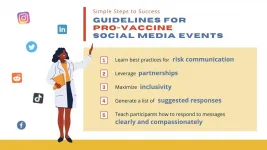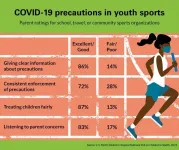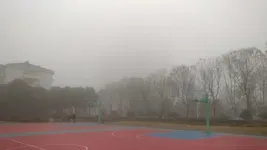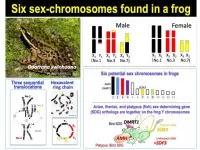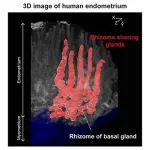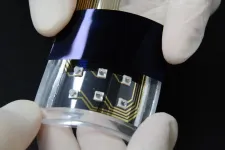(Press-News.org) PITTSBURGH, April 13, 2021 - What can vaccine proponents, clinicians and public health communicators learn from "anti-vaxxers?" A lot, according to new guidance for pro-vaccination social media events written by University of Pittsburgh health scientists.
The five-part guidelines, published today in the journal Vaccine, arose from an analysis of a grassroots pro-vaccination campaign organized last year by popular physician and social media personality Zubin Damania, M.D., colloquially known as "ZDoggMD." Unexpectedly, more than three-quarters of the tweets associated with the event were opposing vaccination, researchers found.
"While at first it felt a little defeating that the event was co-opted to spread anti-vaccination messages, we learned some really constructive lessons," said lead author Beth Hoffman, M.P.H., a doctoral student at Pitt's Graduate School of Public Health. "I expect our guidelines will prove valuable now as health professionals work to address COVID-19 vaccine hesitancy and misinformation, as well as in the development of future health communication campaigns to promote vaccines."
Following two separate instances in November 2019 and January 2020 where vaccination antagonists launched social media attacks, as well as harassed and personally threatened clinicians who had posted positively on social media about vaccination, ZDoggMD called on all health care professionals and vaccine advocates to speak up in support of vaccines using the hashtag #DoctorsSpeakUp on March 5, 2020. The event was supported by Shots Heard Round the World, a project of Public Good Projects (PGP), a public health nonprofit responsible for some of the nation's most successful health campaigns. Shots Heard was created in 2019 following a coordinated online attack against pediatrics practice Kids Plus Pediatrics.
Hoffman and her team turned to Twitter to collect all publicly available tweets with the #DoctorsSpeakUp hashtag posted on March 5, 2020--a total of 106,275 tweets, of which 19,332 were original.
The team then analyzed a random sampling of original tweets, examining the type of account they came from (organization, health care professional, parent or both), whether they had pro- or anti-vaccine attitudes, and whether the tweet gave a personal narrative or made statements about research or science, or both.
The researchers found that 78.9% of the tweets were anti-vaccine, despite the event being organized as a pro-vaccination campaign. Only 5.4% came from "bots," or automated accounts, which is lower than previous studies looking at bots that tweet about vaccines.
"The high level of anti-vaccine tweets and the low use of bots suggest this was a highly coordinated response by anti-vaccine antagonists," said senior author Jaime Sidani, Ph.D., M.P.H., assistant professor of general internal medicine at Pitt. "This was not a coincidental convergence of people with anti-vaccine sentiment, nor was it an attack orchestrated by a few people or organizations deploying bots."
After further examining the tactics the anti-vaccine movement used in co-opting the #DoctorsSpeakUp hashtag and event, Hoffman's team developed guidelines for future pro-vaccine media events:
Use best practices for risk communication, which include sharing personal narratives and citing scientific research.
Leverage partnerships to create a broad coalition of vaccine advocates.
Maximize inclusivity; for example, the #DoctorsSpeakUp hashtag didn't represent the full complement of pro-vaccine advocates, which include nurses and parents, among others.
Share a list of suggested tweets with stakeholders and potential participants prior to the event.
Train event participants on responding to messages clearly and with compassion.
"Health professionals are highly trusted, but if they're interacting only inside the four walls of an exam room, then they may not be providing their patients with health information when and where they need it," said co-author Todd Wolynn, M.D., pediatrician and chief executive officer of Kids Plus Pediatrics and founder of the Shots Heard Round the World project to aid health professionals targeted for their vaccine advocacy.
"True anti-vaccine antagonists are a very small group, but very effective communicators. About 20% of the general population can be described as vaccine hesitant--and many turn to social media with questions," he said. "It's critical that clinicians meet these people where they are, on social media, and learn how to use it effectively to counter anti-vaxxers and inoculate the public against misinformation."
With a grant from the Richard King Mellon Foundation, the Pitt team is expanding upon this work to investigate COVID-19 vaccine misinformation by analyzing how people are connected on Twitter and what messages are being shared. The goal is to guide the creation and dissemination of effective educational messaging about the COVID-19 vaccines that can be shared through multiple platforms--social media, television, in-person discussions--to help people who may be hesitant to receive a vaccine make fact-based decisions.
INFORMATION:
Additional authors on this research are Jason B. Colditz, M.Ed., Ariel Shensa, Ph.D., M.A., Riley Wolynn, Sanya Bathla Taneja, M.S., and Elizabeth M. Felter, Dr.P.H., M.C.H.E.S., all of Pitt.
This research was supported by a National Cancer Institute grant R01CA225773. Technical infrastructure was supported through National Science Foundation awards ACI-1548562 and 1445606 at the Pittsburgh Supercomputing Center.
To read this release online or share it, visit https://www.upmc.com/media/news/041321-hoffman-shots-heard [when embargo lifts].
About the University of Pittsburgh Schools of the Health Sciences
The University of Pittsburgh Schools of the Health Sciences include the schools of Medicine, Nursing, Dental Medicine, Pharmacy, Health and Rehabilitation Sciences and the Graduate School of Public Health. The schools serve as the academic partner to the UPMC (University of Pittsburgh Medical Center). Together, their combined mission is to train tomorrow's health care specialists and biomedical scientists, engage in groundbreaking research that will advance understanding of the causes and treatments of disease and participate in the delivery of outstanding patient care. Since 1998, Pitt and its affiliated university faculty have ranked among the top 10 educational institutions in grant support from the National Institutes of Health. For additional information about the Schools of the Health Sciences, please visit http://www.health.pitt.edu.
http://www.upmc.com/media
Contact: Allison Hydzik, University of Pittsburgh
Office: 412-647-9975
Mobile: 412-559-2431
E-mail: HydzikAM@upmc.edu
Contact: Chad Hermann, Kids Plus Pediatrics
Mobile: 412-427-7178
E-mail: chad@kidspluspgh.com
ANN ARBOR, Mich. -- For young athletes, the new normal on soccer fields and basketball courts means temperature checks before practice, wearing masks through games and a sparse in-person fan base.
But that hasn't kept children and teens from playing. Close to a fourth of parents say their child has participated in school, travel, or community sports during the fall or winter months, according to the C.S. Mott Children's Hospital National Poll on Children's Health at the University of Michigan.
And while the majority of parents give their child's sports organization high marks for communication about safety protocols, one in four rate their sports ...
Hamilton, ON (April 13, 2021) - Ontario doctors are still hesitant to prescribe medical cannabis to patients suffering long-term pain 20 years after it was first introduced, says a new study carried out at McMaster University.
Physicians surveyed said their main concerns relate to possible ill-effects and a lack of understanding regarding their effectiveness as painkillers.
Of particular concern among doctors were potentially harmful effects on cognitive development, a possible worsening of existing mental illnesses in patients and the drug's effects in older adults, which may include dizziness or drowsiness.
Meanwhile, the ...
As the foremost economic zone in China, the Yangtze River Delta (YRD) region has recently been experiencing more frequent haze events, resulting in dramatic damages to human and ecosystem health.
Anthropogenic aerosol emissions play a key role in affecting the formation of haze events. However, aside from local sources of pollution, some studies have found that external and preceding climate drivers, such as Arctic sea ice and subtropical western Pacific sea surface temperature, are also influential factors. However, most research has mainly been confined to analyzing the effects on haze pollution in the Northern Hemisphere, with few considering the Southern Hemisphere.
"We found that the December sea surface temperature ...
Scientists found six sex chromosomes in the Odorrana swinhoana frog species endemic in Taiwan, giving new insights into how complex XY systems evolve.
The discovery was a surprise to the international research team led by Associate Professor Ikuo Miura of Hiroshima University's Amphibian Research Center. In 1980, the first reported instance of multiple sex chromosome systems in amphibians was found in the Taiwanese brown frog Raina narina -- a synonym for O. swinhoana -- which had a male-specific translocation between two chromosomes. Its sex chromosomes could be described as ?X1Y1X2Y2-?X1X1X2X2.
The ...
Niigata, Japan- New insights into the three-dimensional (3D) morphology of the human uterine endometrium could advance our understanding of the mechanisms of endometrial regeneration and fertilized egg implantation while clarifying the pathogenesis of menstrual disorders, infertility and endometrium-related diseases such as adenomyosis, endometriosis, endometrial hyperplasia and endometrial cancer.
The endometrial glands are comprised of complicated winding and branching structures, and conventional 2D imaging techniques have been unable to adequately assess their shape. This limitation has prevented elucidation of the mechanisms of endometrial regeneration during the menstrual cycle and the location of endometrial progenitor cells. Recent developments in 3D tissue-clearing imaging ...
A Korean research team succeeded in developing a technology generating various vibration using LED light signals. The technology allows various tactile sensations by area and reduction in size by considerably lowering the cost of light source, and these are expected to be applied to many industries including automobile and electronics.
The Electronics and Telecommunications Research Institute, or ETRI for short, announced that it succeeded in developing a technology to implement various vibrations using LED. This technology was widely recognized as published on the cover of the February 10 issue of ACS Applied Materials & Interfaces1), a leading ...
Researchers have answered key questions to help prevent damage and improve the safety of hydraulic systems used for pipelines, water turbines and other applications.
The work, led by engineers at the University of Waterloo, investigates a phenomenon known as cavitation, or the formation and collapse of destructive gas-filled bubbles resulting from rapid pressure changes in liquids.
Cavitation is behind a well-known party trick that involves shattering the bottom of a liquid-filled bottle by striking its open top with the palm of your hand.
"The growth and collapse of cavitation bubbles are fascinating," said Zhao Pan, a professor of mechanical and mechatronics engineering who led the research. ...
RICHMOND, Va. (April 12, 2021) -- E-cigarettes that deliver a cigarette-like amount of nicotine are associated with reduced smoking and reduced exposure to the major tobacco-related pulmonary carcinogen, NNAL, even with concurrent smoking, according to a new study led by researchers at Virginia Commonwealth University and Penn State College of Medicine in Hershey, Pennsylvania.
The study, which will be published in The Lancet Respiratory Medicine journal, provides new and important information for smokers who may be trying to use e-cigarettes as a means to cut down on their smoking habit and lower their exposure to harmful toxicants.
"[We found] e-cigarettes with nicotine delivery like a combustible cigarette were effective in helping reduce ...
Toronto (April 12, 2021) - Researchers from University Health Network have developed and validated an innovative deep learning model to predict a patient's long-term outcome after receiving a liver transplant.
First of its kind in the field of Transplantation, this model is the result from a collaboration between the Ajmera Transplant Centre and Peter Munk Cardiac Centre. The study, published in Lancet Digital Health, shows it can significantly improve long-term survival and quality of life for liver transplant recipients.
"Historically, we have seen good advances in one-year post-transplant outcomes, but survival in the longer term hasn't significantly improved in the past decades," explains Dr. Mamatha Bhat, a hepatologist with the Ajmera Transplant Centre ...
Convenience and access win out over reputation when people over 50 look for a doctor for themselves, a new study finds.
But online ratings and reviews of physicians play an important role, and should receive attention from providers and policymakers, the researchers say.
About 20% of older adults called such ratings very important to them, but 43% said they had checked such reviews in the past for physicians they were considering for themselves.
Still, factors like insurance acceptance, appointment availability, location and hours won out over reputational information, although about 40% said a recommendation from another physician was very important to them. Recommendations from family and friends ...
